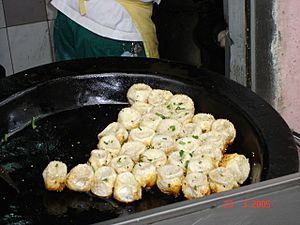Shengjian mantou facts for kids
 |
|
| Alternative names | Shengjian bao |
|---|---|
| Type | Baozi |
| Place of origin | China |
| Region or state | Shanghai |
| Main ingredients | Dough, pork, gelatin |
| Shengjian mantou | |||||||||
|---|---|---|---|---|---|---|---|---|---|
| Simplified Chinese | 生煎馒头 | ||||||||
| Traditional Chinese | 生煎饅頭 | ||||||||
| Literal meaning | raw-fried buns | ||||||||
|
|||||||||
Shengjian mantou, also called shengjian bao, is a yummy pan-fried bun. It's a special food from Shanghai, China. These small buns are usually filled with pork and a special jelly called gelatin. When cooked, the gelatin melts into a warm, tasty soup inside the bun! In Shanghai, these buns have thin, crispy outsides. But if you find them elsewhere, they might have thicker, bread-like skins. Shengjian mantou has been a popular breakfast in Shanghai since the early 1900s. It's a very important part of Shanghai cuisine.
Contents
What's in a Name?
In most modern Chinese, a bun with a filling is called a baozi. A plain, unfilled bun is usually called a mantou.
But in the Jiangnan area, where Wu Chinese is spoken, the word mantou can mean both filled and unfilled buns. This is how it was in older Chinese. That's why shengjian mantou is called a mantou, even though it has a delicious filling.
Making Shengjian Buns
What Ingredients Are Used?
Shengjian buns are made from a special dough that rises a little. This dough wraps around a filling of pork and gelatin.
When the buns are cooking, chopped green onions and sesame seeds are sprinkled on top. These add extra flavor and a nice look.
How Are They Cooked?
The way these buns are cooked gives them their name. They are placed in a large, shallow, oiled pan. Big pans used by shops can be more than a meter wide!
The buns are lined up with the "knot" (where the dough is folded) facing down. This means the knot touches the hot, oiled pan directly. This part gets fried until it's super crispy.
While cooking, water is sprayed on the buns. This helps the top part, which isn't touching the pan, cook properly. After frying, the bottom is crunchy, and the gelatin inside melts into a yummy soup. This mix of crunchy outside and soupy inside makes shengjian unique!
Because the buns are packed tightly in the pan, they often become a bit cube-shaped when cooked. Sometimes, the chef will flip the buns over after cooking. This keeps the crispy bottom from getting soft while they wait to be served.
Different Fillings
The traditional shengjian bun has a pork filling. But you can find other tasty versions too! Some popular ones include chicken, pork mixed with prawns, or pork mixed with crab meat.
How to Enjoy Shengjian
Shengjian buns are usually sold in sets of four. They are a popular breakfast food in Shanghai. You can eat them with a small bowl of clear soup.
Many people like to dip their shengjian buns in Chinkiang vinegar. Because of their crispy, firm bottom, these buns are easy to carry. They are often packed in paper bags for take-away meals.
Some shops sell shengjian all day long as a dianxin (a snack). They are rarely served as part of a main meal.
See also
 In Spanish: Shengjian mantou para niños
In Spanish: Shengjian mantou para niños

